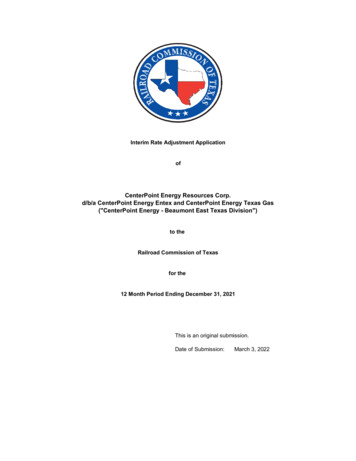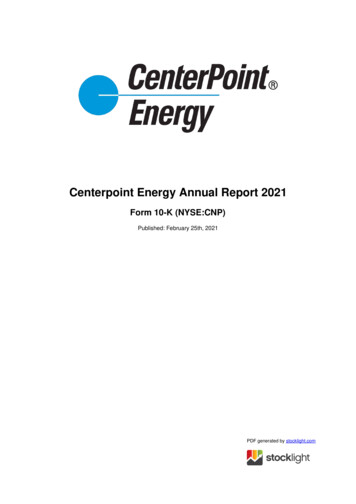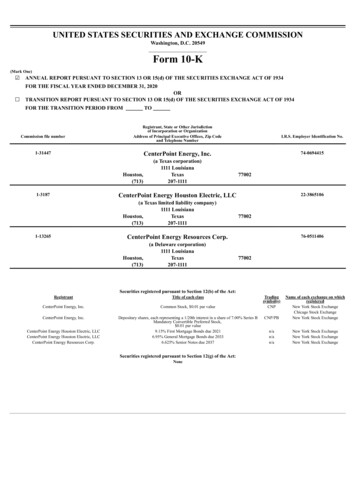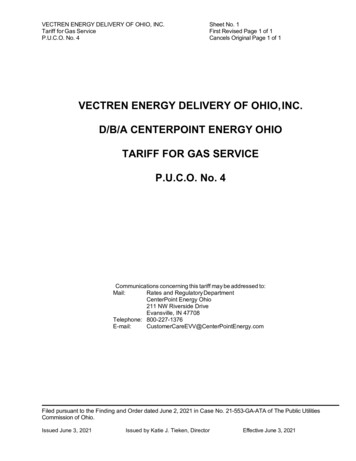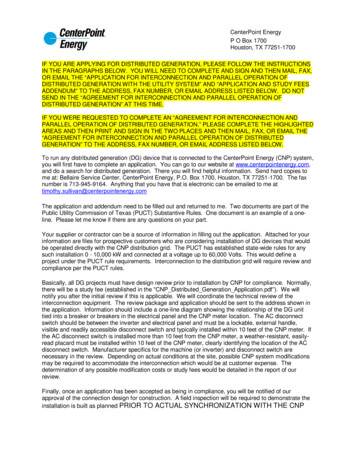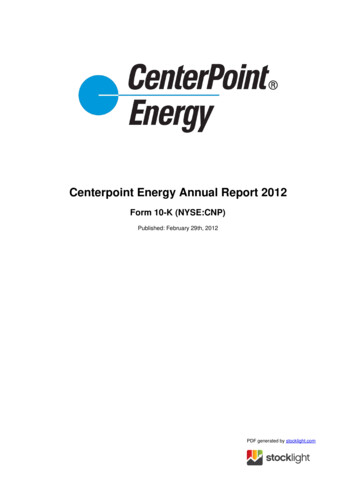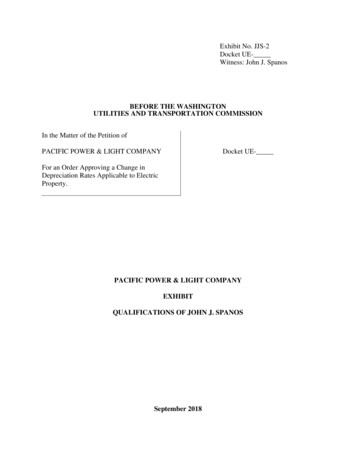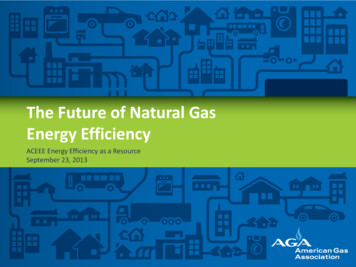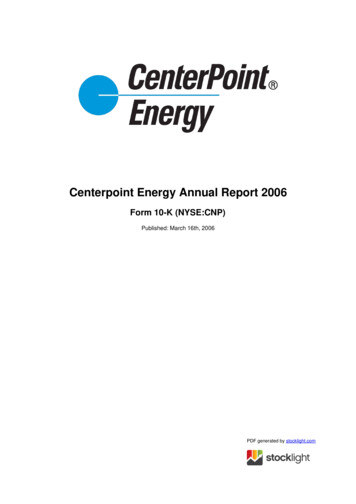
Transcription
Centerpoint Energy Annual Report 2006Form 10-K (NYSE:CNP)Published: March 16th, 2006PDF generated by stocklight.com
------------------------------ ------------------------------ UNITEDSTATES SECURITIES AND EXCHANGE COMMISSION WASHINGTON, D.C. 20549 --------------------- FORM 10-K(Mark One) --------- [X]ANNUALREPORTPURSUANTTOSECTION 13OR 15(d) OFTHESECURITIESEXCHANGEACT OF1934 FORTHE FISCALYEARENDEDDECEMBER31, 2005 OR[]TRANSITIONREPORTPURSUANTTOSECTION 13OR 15(d) OFTHESECURITIESEXCHANGEACT OF1934 FORTHETRANSITIONPERIODFROMTOCOMMISSION FILE NUMBER 1-31447 --------------------- CENTERPOINT ENERGY, INC. (Exact name of registrant as specified inits charter) TEXAS 74-0694415 (State or other jurisdiction of incorporation or (I.R.S. Employer Identification No.) organization)1111 LOUISIANA (713) 207-1111 HOUSTON, TEXAS 77002 (Registrant's telephone number, including area (Address and zipcode of principal executive code) offices)SECURITIES REGISTERED PURSUANT TO SECTION 12(b) OF THE ACT:
TITLE OFEACH CLASSNAME OFEACHEXCHANGEON WHICHREGISTERED------------------- --------------------------------------CommonStock, 0.01par value andassociatedNew YorkStockExchangerights topurchasepreferredstock ChicagoStockExchangeHL&P CapitalTrust II8.257%CapitalSecurities,Series B NewYork StockExchangeSECURITIES REGISTERED PURSUANT TO SECTION 12(g) OF THE ACT: NONE Indicate by check mark if the registrant is awell-known seasoned issuer, as defined in Rule 405 of the Securities Act. Yes [X] No [ ] Indicate by check mark if the registrantis not required to file reports pursuant to Section 13 or Section 15(d) of the Act. Yes [ ] No [X] Indicate by check mark whetherthe registrant: (1) has filed all reports required to be filed by Section 13 or 15(d) of the Securities Exchange Act of 1934 duringthe preceding 12 months (or for such shorter period that the registrant was required to file such reports), and (2) has beensubject to such filing requirements for the past 90 days. Yes [X] No [ ] Indicate by check mark if disclosure of delinquent filerspursuant to Item 405 of Regulation S-K is not contained herein and will not be contained, to the best of each of the registrants'knowledge, in definitive proxy or information statements incorporated by reference in Part III of this Form 10-K or anyamendment to this Form 10-K. [X] Indicate by check mark whether the registrant is a large accelerated filer, an accelerated filer,or a non-accelerated filer. See definition of "accelerated filer and large accelerated filer" in Rule 12b-2 of the Exchange Act.(Check one): Large accelerated filer [X] Accelerated filer [ ] Non-accelerated filer [ ] Indicate by check mark whether the registrantis a shell company (as defined in Rule 12b-2 of the Exchange Act). Yes [ ] No [X] The aggregate market value of the voting stockheld by non-affiliates of CenterPoint Energy, Inc. (Company) was 4,069,064,426 as of June 30, 2005, using the definition ofbeneficial ownership contained in Rule 13d-3 promulgated pursuant to the Securities Exchange Act of 1934 and excludingshares held by directors and executive officers. As of February 28, 2006, the Company had 310,849,323 shares of CommonStock outstanding. Excluded from the number of shares of Common Stock outstanding are 166 shares held by the Company astreasury stock. DOCUMENTS INCORPORATED BY REFERENCE Portions of the definitive proxy statement relating to the 2006Annual Meeting of Shareholders of the Company, which will be filed with the Securities and Exchange Commission within 120days of December 31, 2005, are incorporated by reference in Item 10, Item 11, Item 12, Item 13 and Item 14 of Part III of thisForm 10-K. ------------------------------ -----------------------------TABLE OF CONTENTS
PAGE ----- PART I Item 1.Business.1 Item 1A. RiskFactors. 21Item 1B. Unresolved StaffComments. 28 Item2.Properties.28 Item 3. LegalProceedings.28 Item 4. Submission of Matters to aVote of Security Holders. 28 PART IIItem 5. Market for Registrants' CommonEquity, Related Stockholder Matters andIssuer Purchases of EquitySecurities. 29 Item 6. SelectedFinancial Data. 30Item 7. Management's Discussion andAnalysis of Financial Condition andResults ofOperations. 32 Item7A. Quantitative and QualitativeDisclosures About MarketRisk.56 Item 8. Financial Statements andSupplementary Data. 59 Item9. Changes in and Disagreements withAccountants on Accounting and FinancialDisclosure. 117Item 9A. Controls andProcedures. 117Item 9B. OtherInformation.120 PART III Item 10. Directors andExecutive Officers. 121Item 11. ExecutiveCompensation.121 Item 12. Security Ownership ofCertain Beneficial Owners andManagement and Related StockholderMatters. 121 Item 13. CertainRelationships and RelatedTransactions. 121 Item 14.Principal Accountant Fees andServices. 121 PART IV Item15. Exhibits and Financial StatementSchedules. 122i CAUTIONARY STATEMENT REGARDING FORWARD-LOOKING INFORMATION From time to time we make statementsconcerning our expectations, beliefs, plans, objectives, goals, strategies, future events or performance and underlyingassumptions and other statements that are not historical facts. These statements are "forward-looking statements" within themeaning of the Private Securities Litigation Reform Act of 1995. Actual results may differ materially from those expressed orimplied by these statements. You can generally identify our forward-looking statements by the words "anticipate," "believe,""continue," "could," "estimate," "expect," "forecast," "goal," "intend," "may," "objective," "plan," "potential," "predict," "projection,""should," "will," or other similar words. We have based our forward-looking statements on our management's beliefs andassumptions based on information available to our management at the time the statements are made. We caution you thatassumptions, beliefs, expectations, intentions and projections about future events may and often do vary materially from actualresults. Therefore, we cannot assure you that actual results will not differ materially from those expressed or implied by ourforward-looking statements. Some of the factors that could cause actual results to differ from those expressed or implied by ourforward-looking statements are described under "Risk Factors" in Item 1A of this report. You should not place undue reliance onforward-looking statements. Each forward-looking statement speaks only as of the date of the particular statement. ii PART IITEM 1. BUSINESS OUR BUSINESS OVERVIEW We are a public utility holding company whose indirect wholly ownedsubsidiaries include: - CenterPoint Energy Houston Electric, LLC (CenterPoint Houston), which provides electric transmissionand distribution services to retail electric providers serving approximately 1.9 million metered customers in a 5,000-square-milearea of the Texas Gulf Coast that has a population of approximately 4.8 million people and includes Houston; and - CenterPointEnergy Resources Corp. (CERC Corp. and, together with its subsidiaries, CERC), which owns gas distribution systems servingapproximately 3.1 million customers in Arkansas, Louisiana, Minnesota, Mississippi, Oklahoma and Texas. Through whollyowned subsidiaries, CERC also owns two interstate natural gas pipelines and gas gathering systems, provides various ancillaryservices, and offers variable and fixed-price physical natural gas supplies primarily to commercial and industrial customers andelectric and gas utilities. Our reportable business segments are Electric Transmission & Distribution, Natural Gas Distribution,Competitive Natural Gas Sales and Services, Pipelines and Field Services (formerly Pipelines and Gathering), and OtherOperations. The operations of Texas Genco Holdings, Inc. (Texas Genco), formerly our majority owned generating subsidiary,
the sale of which was completed in April 2005, are presented as discontinued operations. We were a registered public utilityholding company under the Public Utility Holding Company Act of 1935, as amended (the 1935 Act). The 1935 Act and relatedrules and regulations imposed a number of restrictions on our activities and those of our subsidiaries. The Energy Policy Act of2005 (Energy Act) repealed the 1935 Act effective February 8, 2006, and since that date we and our subsidiaries have no longerbeen subject to restrictions imposed under the 1935 Act. The Energy Act includes a new Public Utility Holding Company Act of2005 (PUHCA 2005), which grants to the Federal Energy Regulatory Commission (FERC) authority to require holdingcompanies and their subsidiaries to maintain certain books and records and make them available for review by the FERC andstate regulatory authorities in certain circumstances. On December 8, 2005, the FERC issued rules implementing PUHCA 2005that will require us to notify the FERC of our status as a holding company and to maintain certain books and records and makethese available to the FERC. The FERC continues to consider motions for rehearing or clarification of these rules. Our principalexecutive offices are located at 1111 Louisiana, Houston, Texas 77002 (telephone number: 713-207-1111). We make availablefree of charge on our Internet website our annual report on Form 10-K, quarterly reports on Form 10-Q, current reports on Form8-K and amendments to those reports filed or furnished pursuant to Section 13(a) or 15(d) of the Securities Exchange Act of1934 as soon as reasonably practicable after we electronically file such reports with, or furnish them to, the Securities andExchange Commission (SEC). Additionally, we make available free of charge on our Internet website: - our Code of Ethics forour Chief Executive Officer and Senior Financial Officers; - our Ethics and Compliance Code; - our Corporate GovernanceGuidelines; and - the charters of our audit, compensation, finance and governance committees. Any shareholder who sorequests may obtain a printed copy of any of these documents from us. Changes in or waivers of our Code of Ethics for ourChief Executive Officer and Senior Financial Officers and waivers of our Ethics and Compliance Code for directors or executiveofficers will be posted on our Internet website 1 within five business days and maintained for at least 12 months or reported onItem 5.05 of our Forms 8-K. Our website address is www.centerpointenergy.com. Except to the extent explicitly stated herein,documents and information on our website are not incorporated by reference herein. ELECTRIC TRANSMISSION &DISTRIBUTION Electric Transmission On behalf of retail electric providers, CenterPoint Houston delivers electricity from powerplants to substations and from one substation to another and to retail electric customers taking power above 69 kilovolts (kV) inlocations throughout the control area managed by the Electric Reliability Council of Texas, Inc. (ERCOT). CenterPoint Houstonprovides transmission services under tariffs approved by the Public Utility Commission of Texas (Texas Utility Commission).Electric Distribution In ERCOT, end users purchase their electricity directly from certificated "retail electric providers."CenterPoint Houston delivers electricity for retail electric providers in its certificated service area by carrying lower-voltage powerfrom the substation to the retail electric customer. Its distribution network receives electricity from the transmission grid throughpower distribution substations and delivers electricity to end users through distribution feeders. CenterPoint Houston'soperations include construction and maintenance of electric transmission and distribution facilities, metering services, outageresponse services and call center operations. CenterPoint Houston provides distribution services under tariffs approved by theTexas Utility Commission. Texas Utility Commission rules and market protocols govern the commercial operations of distributioncompanies and other market participants. ERCOT Market Framework CenterPoint Houston is a member of ERCOT. ERCOTserves as the regional reliability coordinating council for member electric power systems in Texas. ERCOT membership is opento consumer groups, investor and municipally owned electric utilities, rural electric cooperatives, independent generators, powermarketers and retail electric providers. The ERCOT market includes much of the State of Texas, other than a portion of thepanhandle, a portion of the eastern part of the state bordering Louisiana and the area in and around El Paso. The ERCOTmarket represents approximately 85% of the demand for power in Texas and is one of the nation's largest power markets. TheERCOT market includes an aggregate net generating capacity of approximately 77,000 megawatts. There are only limited directcurrent interconnections between the ERCOT market and other power markets in the United States. The ERCOT marketoperates under the reliability standards set by the North American Electric Reliability Council. The Texas Utility Commission hasprimary jurisdiction over the ERCOT market to ensure the adequacy and reliability of electricity supply across the state's maininterconnected power transmission grid. The ERCOT independent system operator (ERCOT ISO) is responsible for maintainingreliable operations of the bulk electric power supply system in the ERCOT market. Its responsibilities include ensuring thatelectricity production and delivery are accurately accounted for among the generation resources and wholesale buyers andsellers. Unlike certain other regional power markets, the ERCOT market is not a centrally dispatched power pool, and theERCOT ISO does not procure energy on behalf of its members other than to maintain the reliable operations of the transmissionsystem. Members who sell and purchase power are responsible for contracting sales and purchases of power bilaterally. TheERCOT ISO also serves as agent for procuring ancillary services for those members who elect not to provide their own ancillaryservices. CenterPoint Houston's electric transmission business, along with those of other owners of transmission facilities inTexas, supports the operation of the ERCOT ISO. The transmission business has planning, design, construction, operation andmaintenance responsibility for the portion of the transmission grid and for the load-serving substations it owns, primarily within itscertificated area. We participate with the ERCOT ISO and other ERCOT utilities to plan, design, obtain regulatory approval forand construct new transmission lines 2 necessary to increase bulk power transfer capability and to remove existing constraintson the ERCOT transmission grid. True-Up and Securitization The Texas Electric Choice Plan (Texas electric restructuring law),which became effective in September 1999, substantially amended the regulatory structure governing electric utilities in order toallow retail competition for electric customers beginning in January 2002. The Texas electric restructuring law requires the TexasUtility Commission to conduct a "true-up" proceeding to determine CenterPoint Houston's stranded costs and certain other costsresulting from the transition to a competitive retail electric market and to provide for its recovery of those costs. In March 2004,CenterPoint Houston filed its true-up application with the Texas Utility Commission, requesting recovery of 3.7 billion, excludinginterest. In December 2004, the Texas Utility Commission issued its final order (True-Up Order) allowing CenterPoint Houston torecover a true-up balance of approximately 2.3 billion, which included interest through August 31, 2004, and providing foradjustment of the amount to be recovered to include interest on the balance until recovery, the principal portion of additionalexcess mitigation credits returned to customers after August 31, 2004 and certain other matters. CenterPoint Houston and otherparties filed appeals of the True-Up Order to a district court in Travis County, Texas. In August 2005, the court issued its finaljudgment on the various appeals. In its judgment, the court affirmed most aspects of the True-Up Order, but reversed two of theTexas Utility Commission's rulings. The judgment would have the effect of restoring approximately 650 million, plus interest, ofthe 1.7 billion the Texas Utility Commission had disallowed from CenterPoint Houston's initial request. First, the court reversedthe Texas Utility Commission's decision to prohibit CenterPoint Houston from recovering 180 million in credits through August2004 that CenterPoint Houston was ordered to provide to retail electric providers as a result of an inaccurate stranded cost
estimate made by the Texas Utility Commission in 2000. Additional credits of approximately 30 million were paid after August2004. Second, the court reversed the Texas Utility Commission's disallowance of 440 million in transition costs which arerecoverable under the Texas Utility Commission's regulations. CenterPoint Houston and other parties appealed the district courtdecisions. Briefs have been filed with the 3rd Court of Appeals in Austin but oral argument has not yet been scheduled. Amongthe issues raised in our appeal of the True-Up Order is the Texas Utility Commission's reduction of our stranded cost recoveryby approximately 146 million for the present value of certain deferred tax benefits associated with our former Texas Gencoassets. Such reduction was considered in our recording of an after-tax extraordinary loss of 977 million in the last half of 2004.We believe that the Texas Utility Commission based its order on proposed regulations issued by the Internal Revenue Service(IRS) in March 2003 related to those tax benefits. Those proposed regulations would have allowed utilities which werederegulated before March 4, 2003 to make a retroactive election to pass the benefits of Accumulated Deferred Investment TaxCredits (ADITC) and Excess Deferred Federal Income Taxes (EDFIT) back to customers. However, in December 2005, the IRSwithdrew those proposed normalization regulations and issued new proposed regulations that do not include the provisionallowing a retroactive election to pass the tax benefits back to customers. If the December 2005 proposed regulations becomeeffective and if the Texas Utility Commission's order on this issue is not reversed on appeal or the amount of the tax benefits isnot otherwise restored by the Texas Utility Commission, the IRS is likely to consider that a "normalization violation" has occurred.If so, the IRS could require us to pay an amount equal to CenterPoint Houston's unamortized ADITC balance as of the date thatthe normalization violation was deemed to have occurred. In addition, if a normalization violation is deemed to have occurred, theIRS could also deny CenterPoint Houston the ability to elect accelerated depreciation benefits. The Texas Utility Commissionhas not previously required a company subject to its jurisdiction to take action that would result in a normalization violation. Thereare two ways for CenterPoint Houston to recover the true-up balance: by issuing transition bonds to securitize the amounts dueand/or by implementing a competition transition charge (CTC). Pursuant to a financing order issued by the Texas UtilityCommission in March 2005 and affirmed in all respects in August 2005 by the same Travis County District Court considering theappeal of the True-Up Order, in December 2005 a subsidiary of CenterPoint Houston issued 1.85 billion in transition bonds withinterest rates ranging 3 from 4.84 percent to 5.30 percent and final maturity dates ranging from February 2011 to August 2020.Through issuance of the transition bonds, CenterPoint Houston recovered approximately 1.7 billion of the true-up balancedetermined in the True-Up Order plus interest through the date on which the bonds were issued. In July 2005, CenterPointHouston received an order from the Texas Utility Commission allowing it to implement a CTC which will collect approximately 596 million over 14 years plus interest at an annual rate of 11.075 percent (CTC Order). The CTC Order authorizes CenterPointHouston to impose a charge on retail electric providers to recover the portion of the true-up balance not covered by the financingorder. The CTC Order also allows CenterPoint Houston to collect approximately 24 million of rate case expenses over threeyears through a separate tariff rider (Rider RCE). CenterPoint Houston implemented the CTC and Rider RCE effectiveSeptember 13, 2005 and began recovering approximately 620 million. Certain parties appealed the CTC Order to the TravisCounty Court in September 2005. Under the True-Up Order, CenterPoint Houston is allowed to recover carrying charges at11.075 percent until the true-up balance is recovered. In January 2006, the Texas Utility Commission staff (Staff) proposed thatthe Texas Utility Commission adopt new rules governing the carrying charges on unrecovered true-up balances. If the TexasUtility Commission adopts the rule as the Staff proposed it and the rule is deemed to apply to CenterPoint Houston, the rulewould reduce carrying costs on the unrecovered CTC balance prospectively from 11.075 percent to the utility's cost of debt.CenterPoint Houston Rate Case The Texas Utility Commission requires each electric utility to file an annual Earnings Reportproviding certain information to enable the Texas Utility Commission to monitor the electric utilities' earnings and financialcondition within the state. In May 2005, CenterPoint Houston filed its Earnings Report for the calendar year ended December 31,2004. CenterPoint Houston's Earnings Report shows that it earned less than its authorized rate of return on equity in 2004. InOctober 2005, the Staff filed a memorandum summarizing its review of the Earnings Reports filed by electric utilities. Based onits review, the Staff concluded that continuation of CenterPoint Houston's rates could result in excess retail transmission anddistribution revenues of as much as 105 million and excess wholesale transmission revenues of as much as 31 millionannually and recommended that the Texas Utility Commission initiate a review of the reasonableness of existing rates. TheStaff's analysis was based on a 9.60 percent cost of equity, which is 165 basis points lower than the approved return on equityfrom CenterPoint Houston's last rate proceeding, the elimination of interest on debt that matured in November 2005 and certainother adjustments to CenterPoint Houston's reported information. Additionally, a hypothetical capital structure of 60 percent debtand 40 percent equity was used which varies materially from the actual capital structure of CenterPoint Houston as of December31, 2005 of approximately 50 percent debt and 50 percent equity. In December 2005, the Texas Utility Commission consideredthe Staff report and agreed to initiate a rate proceeding concerning the reasonableness of CenterPoint Houston's existing ratesfor transmission and distribution service and to require CenterPoint Houston to make a filing by April 15, 2006 to justify orchange those rates. These and other significant matters currently affecting our financial condition are further discussed in"Management's Discussion and Analysis of Financial Condition and Results of Operations -- Executive Summary -- SignificantEvents in 2005" in Item 7 of this report. Customers CenterPoint Houston serves nearly all of the Houston/Galveston metropolitanarea. CenterPoint Houston's customers consist of 66 retail electric providers, which sell electricity in its certificated service area,and municipalities, electric cooperatives and other distribution companies located outside CenterPoint Houston's certificatedservice area. Each retail electric provider is licensed by, and must meet creditworthiness 4 criteria established by, the TexasUtility Commission. Two of the retail electric providers in our service area are subsidiaries of Reliant Energy, Inc (RRI). Sales tosubsidiaries of RRI represented approximately 78%, 71% and 62% of CenterPoint Houston's transmission and distributionrevenues in 2003, 2004 and 2005, respectively. CenterPoint Houston's billed receivables balance from retail electric providers asof December 31, 2005 was 127 million. Approximately 56% of this amount was owed by subsidiaries of RRI. CenterPointHouston does not have long-term contracts with any of its customers. It operates on a continuous billing cycle, with meterreadings being conducted and invoices being distributed to retail electric providers each business day. Distribution AutomationCenterPoint Houston, with assistance from IBM, has developed an Electric Distribution Grid Automation Strategy that involvesthe implementation of an "Intelligent Grid". An Intelligent Grid has the potential to provide us with on demand data andinformation that should enable a significant improvement in grid planning, operations and maintenance. This, in turn, shouldcontribute to fewer and shorter outages, better customer service, improved operations costs, improved security and moreeffective use of the workforce. A limited system deployment, with an expected capital cost of 11 million in 2006, has beeninitiated and allows for a disciplined approach to proving the technology and validating potential benefits prior to a full-scaleimplementation. The outcome of this limited deployment will be a major factor in any decision to expand the deployment in 2007
and beyond. Competition There are no other electric transmission and distribution utilities in CenterPoint Houston's service area.In order for another provider of transmission and distribution services to provide such services in CenterPoint Houston's territory,it would be required to obtain a certificate of convenience and necessity from the Texas Utility Commission and, depending onthe location of the facilities, may also be required to obtain franchises from one or more municipalities. We know of no otherparty intending to enter this business in CenterPoint Houston's service area at this time. Seasonality A significant portion ofCenterPoint Houston's revenues is derived from rates that it collects from each retail electric provider based on the amount ofelectricity it distributes on behalf of such retail electric provider. Thus, CenterPoint Houston's revenues and results of operationsare subject to seasonality, weather conditions and other changes in electricity usage, with revenues being higher during thewarmer months. Properties All of CenterPoint Houston's properties are located in Texas. CenterPoint Houston's transmissionsystem carries electricity from power plants to substations and from one substation to another. These substations serve toconnect power plants, the high voltage transmission lines and the lower voltage distribution lines. Unlike the transmissionsystem, which carries high voltage electricity over long distances, distribution lines carry lower voltage power from the substationto the retail electric customers. The distribution system consists primarily of distribution lines, transformers, secondarydistribution lines and service wires and meters. Most of CenterPoint Houston's transmission and distribution lines have beenconstructed over lands of others pursuant to easements or along public highways and streets as permitted by law. All real andtangible properties of CenterPoint Houston, subject to certain exclusions, are currently subject to: - the lien of a Mortgage andDeed of Trust (the Mortgage) dated November 1, 1944, as supplemented; and - the lien of a General Mortgage (the GeneralMortgage) dated October 10, 2002, as supplemented, which is junior to the lien of the Mortgage. 5 As of December 31, 2005,CenterPoint Houston had outstanding 2.0 billion aggregate principal amount of general mortgage bonds under the GeneralMortgage, including approximately 527 million held in trust to secure pollution control bonds for which CenterPoint Energy isobligated and approximately 229 million held in trust to secure pollution control bonds for which CenterPoint Houston isobligated. Additionally, CenterPoint Houston had outstanding approximately 253 million aggregate principal amount of firstmortgage bonds under the Mortgage, including approximately 151 million held in trust to secure certain pollution control bondsfor which CenterPoint Energy is obligated. CenterPoint Houston may issue additional general mortgage bonds on the basis ofretired bonds, 70% of property additions or cash deposited with the trustee. Approximately 2.0 billion of additional first mortgagebonds and general mortgage bonds could be issued on the basis of retired bonds and 70% of property additions as of December31, 2005. However, CenterPoint Houston is contractually prohibited, subject to certain exceptions, from issuing additional firstmortgage bonds. Electric Lines -- Overhead. As of December 31, 2005, CenterPoint Houston owned 27,026 pole miles ofoverhead distribution lines and 3,621 circuit miles of overhead transmission lines, including 451 circuit miles operated at 69,000volts, 2,093 circuit miles operated at 138,
Centerpoint Energy Annual Report 2006 Form 10-K (NYSE:CNP) Published: March 16th, 2006 PDF generated by stocklight.com
